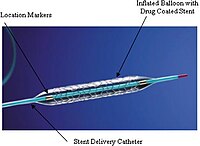
Photo from wikipedia
BACKGROUND The impact of coronary artery disease (CAD) extension/complexity on outcomes and on the comparative benefits/risks of zotarolimus-eluting stent (ZES) versus bare-metal stents (BMS) remains unclear in patients at high… Click to show full abstract
BACKGROUND The impact of coronary artery disease (CAD) extension/complexity on outcomes and on the comparative benefits/risks of zotarolimus-eluting stent (ZES) versus bare-metal stents (BMS) remains unclear in patients at high risk of bleeding or thrombosis or at low restenosis risk. METHODS We performed a post-hoc analysis of the ZEUS trial. The impact of coronary anatomic complexity measured by the SYNTAX score on the differences in outcomes following ZES and BMS was assessed at 1 year. RESULTS The mean SYNTAX score was 16.3 ± 13.1 with a median of 12 (IQR: 7 to 22). We stratified patients according to SYNTAX tertiles (0-8: n = 563; >8-19 n = 532; >19: n = 511), and observed that the higher the score, the correspondingly higher was the rate of the primary endpoint of major adverse cardiovascular events (MACE) and other ischemic events, but not bleeding after adjustment. The superior efficacy of ZES versus BMS for MACE was consistent across SYNTAX tertiles (tertile 1: HR 0.71, 95% CI 0.44-1.13; tertile 2: HR 0.71, 95% CI 0.46-1.09; tertile 3: HR 0.83, 95% CI 0.61-1.10) without significant heterogeneity (p for trend = 0.55). This between-groups difference mainly reflected a reduction in MI and TVR without effect on mortality. There was no significant interaction between the SYNTAX score and allocated stent type with respect to ischemic and bleeding endpoints. CONCLUSIONS The SYNTAX score was predictor of major adverse cardiovascular events but not bleeding and ZES provided superior efficacy and safety than BMS across the whole spectrum of CAD complexity. SYNTAX score may be routinely used for the assessment of the ischemic risk (but not bleeding) after PCI and should not guide the decision-making for DES versus BMS in patients undergoing PCI.
Journal Title: International journal of cardiology
Year Published: 2019
Link to full text (if available)
Share on Social Media: Sign Up to like & get
recommendations!